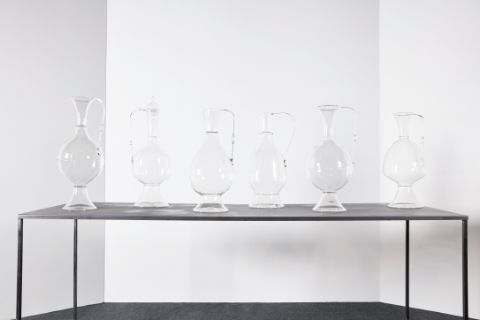Aslan Ġoisum

Aslan Ġoisum, Untitled (2015). Courtesy Emalin und Galerie Zink
To make glass, you need the right bolt of lightning to hit the right spot of sand. Generations of young readers have learned this from Jules Verne’s L’Île mysterieuse, first published in 1875. I read it ninety-eight years later in Swedish translation and could never forget the image of the scientists stepping out onto the beach one morning, only to find it glazed over, quite literally, after a nocturnal thunderstorm. Aslan Ġoisum outsourced the actual glassmaking to those who know it best: the master artisans of Murano in Venice. He asked them to faithfully reproduce, in glass as thin and pure and invisible as possible, several water jugs from his own personal collection. Their shapes are traditional to the different peoples of the North and South Caucasus, and they were meant to be exclusively handled by women. Turning a highly coded premodern use-object into a contemporary art piece unburdened by content or meaning is, first and foremost, a flash of artistic intelligence. Volume becomes abstraction, yet modernity slips away. It also reflects the trans-substantiation of memory—collective and personal, political and cultural, imperial and emancipatory—that is the hallmark of Ġoisum’s practice. —Anders Kreuger
Work in the exhibition: Untitled (2015), six borosilicate glass objects, 61.2 × 26.5 × 26.5 cm; 63.5 × 26.3 × 26.3 cm; 60.5 × 26 × 26 cm; 62.3 × 27.8 × 27.8 cm; 61.2 × 26.5 × 26.5 cm; 66.5 × 26.5 × 26.5 cm. Courtesy of Emalin, London and Galerie Zink, Waldkirchen